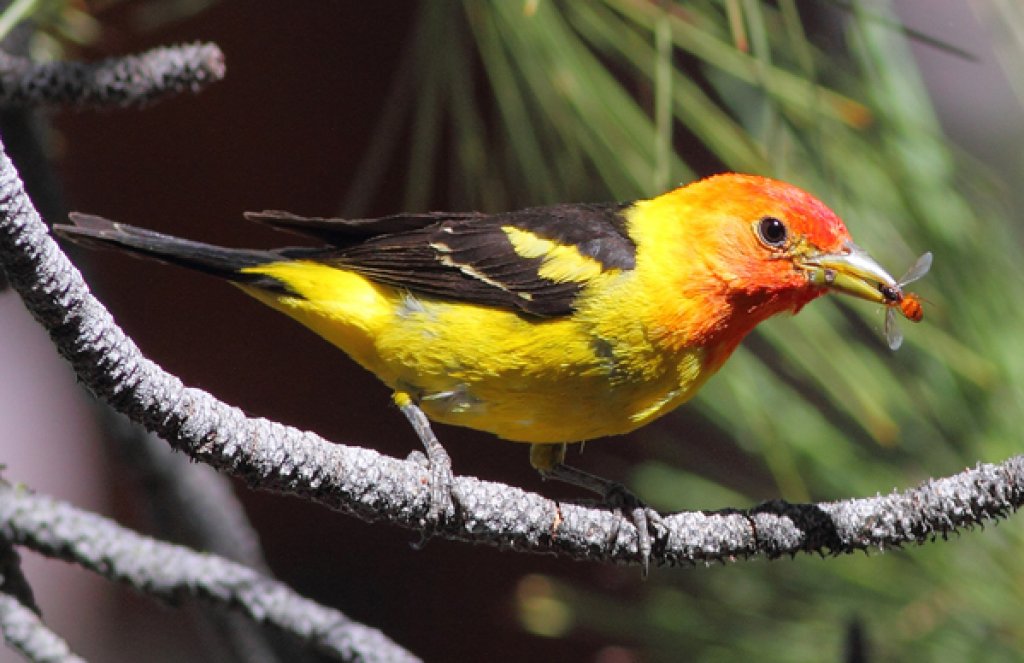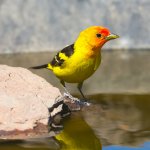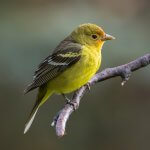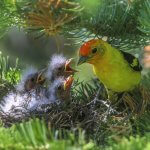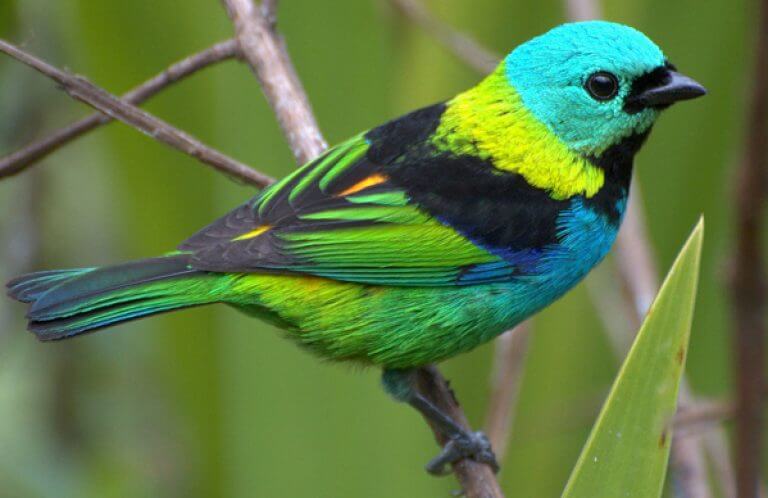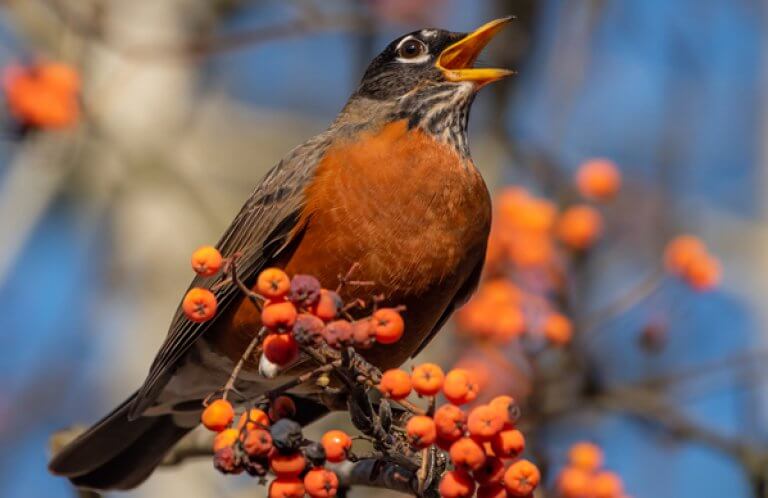About the Western Tanager
The male Western Tanager's glowing yellow and red plumage lights up the coniferous and mixed forests of western North America each spring. The female, a drabber mix of olive-green, gray, and light yellow, virtually disappears into this habitat. Even males can remain surprisingly inconspicuous, however, as this species tends to feed and nest high in the tree canopy like its eastern relative, the Scarlet Tanager.
Once considered a member of the Thraupidae family, which includes spectacularly-colored South American species such as the Green-headed Tanager, new genetic evidence now places the Western Tanager and other tanagers of the Piranga genus into the Cardinalidae, a large and diverse bird family which includes the Northern Cardinal, Painted Bunting, and Dickcissel.
Many birds in this large family have red plumage, but the Western Tanager's is somewhat unusual.
Why the Red Face?
Most birds with red plumage, like the Summer Tanager, owe their color to carotenoid pigments obtained from the birds' diet. However, the red face and head of the male Western Tanager are caused by a carotenoid pigment rarely found in birds, called rhodoxanthin. Rhodoxanthin is found in conifer buds, ferns, and some introduced honeysuckle species. The Western Tanager doesn't eat these things directly, but rather obtains the pigment they contain indirectly by eating insects that feed on conifers.
Songs and Sounds
The Western Tanager's song is similar to an American Robin's, but sounds more hurried and has a rougher tone, like the songs of other tanagers in its genus.
Listen to the Western Tanager's song:
Breeding and Feeding
The Western Tanager is seasonally monogamous. Pairs form on the wintering grounds, or during the birds' spring migrations north. On the breeding grounds, males establish and defend their territory by singing and chasing away intruders.
The female builds a cup-like nest of twigs and grasses high in the tree canopy, lined with softer materials such as lichens, mosses, and rootlets. She then lays her clutch of three to five eggs, which she incubates alone for about two weeks. During this time her mate brings her food. Both parents feed the young after hatching; they fledge in approximately two weeks, and become fully independent about a month after they leave the nest.
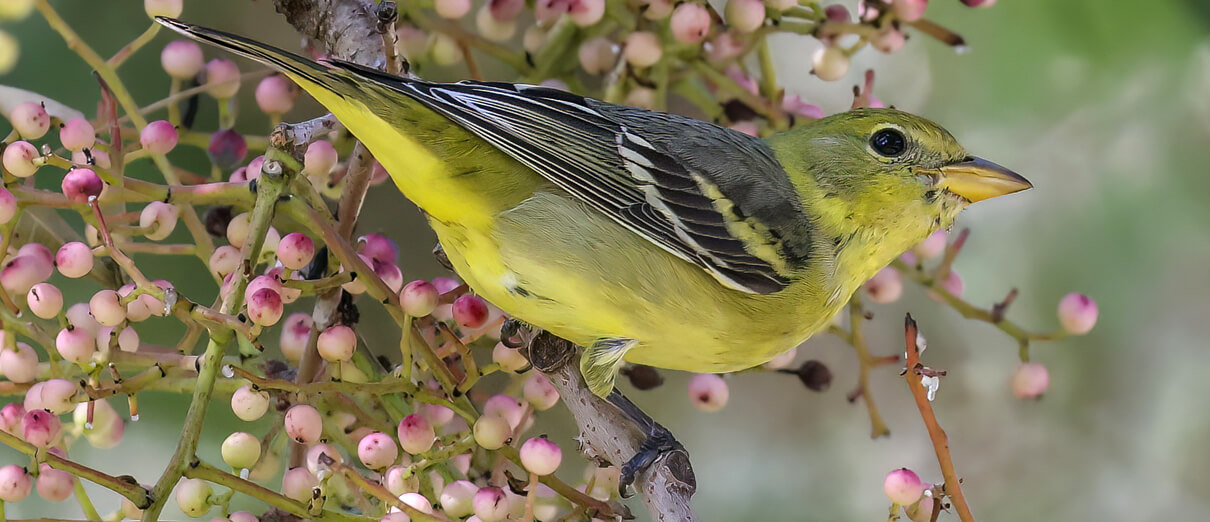
Feeding Like a Flycatcher
The Western Tanager is mainly insectivorous, feeding on a variety of insects, including bees, wasps, grasshoppers, ants, beetles, cicadas, stinkbugs, and termites. During the fall and winter, it adds fruits and seeds to its diet.
This tanager forages in the upper branches of trees, slowly and deliberately gleaning food from branches and foliage. It will also dart out to capture flying insects in the manner of a Great Crested Flycatcher, a hunting method known as hawking or sallying.
Region and Range

Western Tanagers breed farther north than any other American tanager species, up to northwestern Canada. Each fall, they migrate long distances to wintering grounds in southern Mexico and Central America. Some also winter in Southern California.
Conservation of the Western Tanager
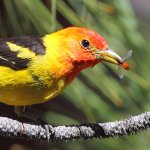
Help support ABC's conservation mission!
Each winter, the Western Tanager joins Ruby-throated Hummingbird, Wood Thrush, and dozens of other migrants in Mexico and Central America, where shade coffee farms provide important habitat. One easy way to help the Western Tanager is to buy Bird Friendly® coffee grown on certified farms within this bird's wintering range.
ABC's work helps to conserve the Western Tanager and other migratory birds across their full annual life cycle through its BirdScapes approach to conservation. Other ABC initiatives tackle threats affecting all migratory birds, including our Cats Indoors program, which encourages pet owners to keep cats and birds safe, and our Glass Collisions program, which offers solutions to keep migrating birds from hitting windows.
Get Involved
Policies enacted by the U.S. Congress and federal agencies, such as the U.S. Fish and Wildlife Service, have a huge impact on migratory birds. You can help shape these rules for the better by telling lawmakers to prioritize birds, bird habitat, and bird-friendly measures. To get started, visit ABC's Action Center.
Living a bird-friendly life can have an immediate impact on migratory birds in the United States. Doing so can be as easy as adding native plants to your garden, avoiding pesticides, and keeping cats indoors. To learn more, visit our Bird-Friendly Life page.
American Bird Conservancy and our Migratory Bird Joint Venture partners have improved conservation management on more than 8.5 million acres of U.S. bird habitat — an area larger than the state of Maryland — over the last ten years. That's not all: With the help of international partners, we've established a network of more than 100 areas of priority bird habitat across the Americas, helping to ensure that birds' needs are met during all stages of their lifecycles. These are monumental undertakings, requiring the support of many, and you can help by making a gift today.





































